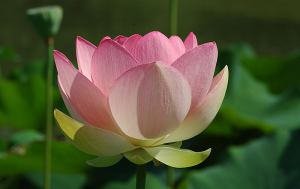Story behind Haripad Ashrama
The past:–
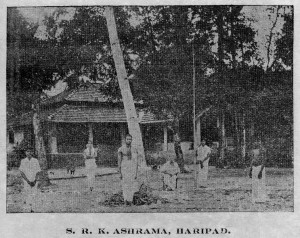
The old Ashram building ( not existing now)
Swami Nirmalananda came to Haripad again on 27th April 1913. This time he was accompanied by Swami Vishudhananda. They discussed with the organizers and Swamiji himself supervised the remaining work for the inauguration. On 4th May 1913 (Malayalam Era 22nd Medam 1088) at six in the morning the function started with reading Sree Rudram, Chandi and Gita, then Vedic Pooja and Homa followed by Inauguration , Bhajans and Procession . Thus The Sri Rama Krishna Ashram Haripad, the first one in the state of Kerala came in to existence.
During April 1914 Swami Nirmalananda again reached Haripad to attend the Sri Ramakrishna Jayanti Sammelan. The celebration was on 10th April. On this occasion one boy from the lower caste was made Brahmachari. After Pooja, Bhajan and discourse a common feast was served. At that period of time people belonging to the lower caste were not allowed to dine with upper caste people. Food was served in plantain leaves. After the feast the organizers belonging to the upper caste were reluctant to remove the leaves. Swamiji understood the situation and started removing the leaves. Immediately members of the Bhakta Sangh rose to the occasion and completed the job.
This was the beginning of a silent revolution in the State. It may be noted that Gandhiji came to Vaikkam in 1936 to attend the Sathyagraha demanding entry of lower caste people to temples. On this occasion a common feast was served. This function attained significance and attained place in the history of Modern India. It took twenty two more years for the political leaders of the nation to organize such a movement. The farsightedness of a single monk with no man power or publicity changed the whole history. The ruling Kingdom of Travancore was pious, generous and closely associated with the Sri Ramakrishna Movement. The Maharaja of Travancore in a declaration proclaimed permission for entry of lower caste people to temples.
Swami Brahmananda reached Olavakkod (Shornnur) railway station on the 26th November 1916 byMadrasmail. From there he boarded a train to Ernakulam. Reached Ernakulam the same day and resided in a two storied building by the side of Periyar (Aluva). Swamiji took a boat trip in the Periyar. Started to Kottayam on the 29th by boat. Spent two days in Kottayam. From Kottayam reached Haripad by car. Swamiji was received in front of Sree Subrahmanya Swamy temple with Poornakumbha, Pallak and Music. Went to the Ashram at Pilapuzha, one and a half kilometers away from the temple, leading a procession. Stayed in the Ashram for three days. He gave initiation to Neelakanta Bhaktan(Swami Purushothamananda) from Thiruvalla and Venkita Subrahmanya Iyer (Swami Chitsukhananda) of Haripad who donated the land for constructing the Ashram. From Haripad Raja Maharaj went to Kollam. Stayed there for two days. From Kollam he went to Thiruvananthapuram and laid the foundation stone of the Sri Ramakrishna Ashram, Nettayam at 8 am on the 9th December 1916. Swamiji reached Kollam on the 30th December. From Kollam went to Ambalapuzha, then to Ernakulam and to Madras. From Madras went to Kolkota.
Swami Nirmalananda again reached Haripad on the 22nd December 1923. The next day he conducted a Viraja Homa at the Ashram and gave Ochre clothes to eleven Brahmacharis. They are Swami Chitsukhananda, Swami Nirvikarananda, Swami Niranjanananda, Swami Sekharananda, Swami Chidambarananda, Swami Naishtikananda, Swami Chitbhasananda, Swami Shubhrananda, Swami Vageeswarananda and Swami Dheeswarananda. Attaining sanyasa Swami Chitsukhananda became head of the Haripad Ashram. The centre developed very fast. Sri Ramakrishna Vidyalaya was established mainly for the study and upliftment of the children belonging to the lower castes. A spinning loom centre was started for vocational training and employment. Charitable and social programmes in addition to spiritual activities were regularly conducted. The Ashram developed as a centre of spiritual excellence. Celeberations were conducted in a royal manner.
From 1942 Swami Sekharananda headed the centre. In 1964 a library was inaugurated by Sri V V Giri, the former President of India while he was The Governor of Kerala. In 1978 the Monk who headed the centre passed away.
FLOW OF EVENTS IN BETWEEN :-
By 1930 a difference of opinion arose between Swami Nirmalananda and some of the Board of Trustees of The Ramakrishna Mission, Belur on his accepting the chairmanship of Vivekananda Mission,Calcutta. This kept him away from the central leadership of the Mission. Swamiji came to Ottappalam and stayed there till his last breath on the 26th April 1938. By this time many centres started functioning in Kerala. Most of the centres including Haripad stood by him and dissociated with Belur Math. When the monk in charge of the Haripad centre passed away nobody in the Sri Ramakrishna order was substituted.
BY THE GRACE OF SRI RAMAKRISHNA, on the 6th October 2007 the Belur Math appointed a sanyasin to head the Haripad centre. From then on it has again become a regular branch centre of Ramakrishna Math & Mission, Belur Math, Howrah.
But the assets and resources flowed away during the custody of the centre with the Receiver. The building, furniture, vessels, library books, every thing even the photos of Guru Maharaj, Mathrudevi, Swamiji Maharaj kept in the shrine vanished, except the Land.
The situation in 2007 when the centre was taken over by Belur Math.(See photos below)
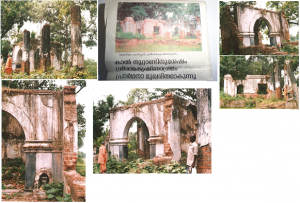
AT PRESENT :–
There are two sites. One, about 27 cents at the National highway where the monks are staying now —photo below
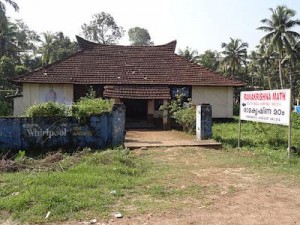
The other one is about 3kms from the highway site. See photo below
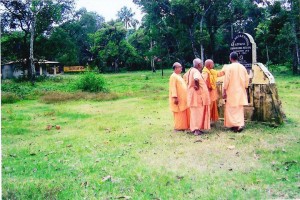
The place is now cleared of dilapidated buildings ( shown above) and it is at this location where the new centre is to be built.
THE STORY (Story of Haripad Centre with more details)
THE SOURCE


THE POWER
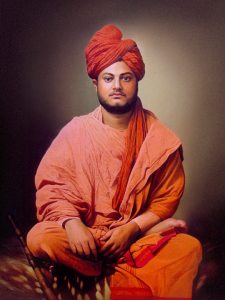
Swami Vivekananda returned toIndiaon the 15th January 1897 after his glorious speech at Chicago Art Institute Columbus hall in the World Parliament of Religions. Swamiji was given an auspicious welcome at Madras(Chennai). There was a huge procession in which he was moving in a cart driven by horses. The over enthusiastic youth and students removed the horses and they themselves drove the cart. At that time many of the students from Kerala were studying at Presidency College Madras. They included Mr. Padmanabhan Thampi, Mr. Raman Thampi, Mr. M.R.Narayana Pillai and others. By this time Ramakrishna Matts were established at Madras and Bangalore. The visit of Swamiji, fame of Chicago conference and the functioning of the Matts at Madras and Bangalore aroused the strong desire for establishing Sri Ramakrishna movement in Kerala.
THE INVITATION
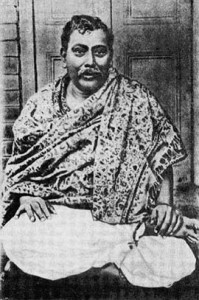
In 1904 Sri Kalipada Ghosh the house hold devotee of Sri Ramakrishna came to Thiruvananthapuram and resided there on his official duty in The John Dickinson Company. Sri Ghosh requested Swami Ramakrishnananda (Sasi Maharaj) who was heading the Madras centre to make a visit to Thiruvananthapuram. He came and stayed there for one month conducting satsangs and giving discourses. Spiritual and intellectual people from the important places of the erstwhile state of Travancore attended these functions. In the mean time the students studied at Madras who witnessed the triumphant welcome function of Swami Vivekananda returned home and obtained key Government Posts. The visit of Swami Ramakrishnananda paved way to the formation of Sri Ramakrishna Bhakta sanghs at Thiruvananthapuram , Haripad and Thiruvalla.
In 1905 Swami Ramakrishnananda came to Alapuzha and laid the foundation stone of the Sanathana Dharma College at Alapuzha managed by the Gauda Saraswath Community which migrated to Kerala from the western costal areas of Karnataka, Goa and other states when their temples and other establishments were attacked and destructed by the Portuguese in the 14th century.
The Ramakrishna Bhakta Sangh at Haripad was headed by Sri Padmanabhan Thampi who was by the time posted as First Class Magistrate of Haripad. The Secretary was Sri Subbaraya Iyer, a lawyer. Haripad was a place of spiritual, cultural and intellectual heritage. The Tamil Brahmin community which migrated from various parts of the erstwhile Madras state during the Muslim invasion in the 16th century was very much dominant in the town. Most of the intellectual personalities in and around the area got associated with the Bhakta Sangh. The functioning of the organization got high momentum.
THE INSPIRATION
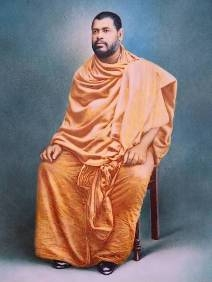
Swami Ramakrishnananda was invited to attend the Sri Ramakrishna Jayanti Sammelan for 1911. Swamijis condition of health became worse. So he advised the organizers of Haripad Bhakta Sangh to invite Swami Nirmalananda (Thulasi Maharaj) who was heading the Bangalore centre to attend the function. The Haripad devotees went to Bangalore and invited Swami Nirmalananda. He readily accepted the request.
Swami Nirmalananda reached Ernakulam south railway station on the 15thFebruary 1911. From Ernakulam he went to Alapuzha in a steam boat. Swamiji was welcomed at Alapuzha by a huge gathering consisting of all section of people including students of Sanathana Dharma Vidyalaya. At SDV School Beasant hall he spoke about Bhakti . The next morning he started to Haripad in a boat. Swamiji was received at Haripad by a huge crowd. The welcome speech was in English and Sanskrit. The next day was Jayanti celebration. There was Bhajan and Procession. About two thousand five hundred people were given feast. In the Sammelan Swamiji spoke about Power (Shakti) inherent in the Hindu religion. The English speech was translated in to Malayalam. The next day he interacted with the students of ShanmughaVilasam School. He gave them many valuable advices, spoke about spiritual subjects and explained some portions of Bhagavad Gita. He spoke about the responsibility of children. He discussed with the members of the Bhakta Sangh about the action plan for the work to be done. After the function Sri Subbaraya Iyer donated Rs1000/-to Swamiji. He told Mr. Iyer to keep the money with him for establishing an Ashram at Haripad. From Haripad Swami Nirmalananda went to Kollam.
THE INAUGURATION
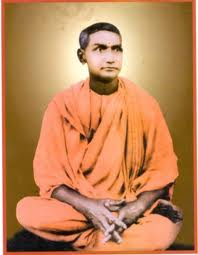
The Bhakta Sangh carried out the work according to the action plan. Regular satsangs, bhajans and other activities were conducted. Schemes were initiated to establish an Ashram. Meanwhile Sri Venkita Krishna Iyer a young devotee donated his land at Pilapuzha by the side of the beautiful paddy field and canals to build the Ashram. Swami Nirmalananda was invited to lay the foundation stone of the Ashram building. Swamiji reached Haripad and laid the foundation stone on Krishnashtami day the 4th September 1912.
Construction of the Ashram went on very fast utilizing the first donation of Rs1000/- given by Sri Subbaraya Iyer and donation from all section of people. Meanwhile Sri Padmanabhan Thampi (later he became Swami Parananda) was transferred from Haripad. The members of the Bhakta Sangh and those associated with the movement were upset. The situation was brought to the notice of swami Nirmalananda. That night Swamiji had a dream in which Swami Vivekananda telling him that the work of GURUMAHARAJ will go on smoothly without any obstacle. The next day Sri Thampi got an order cancelling his transfer. The happiness and enthusiasm of the devotees increased. The work went on smoothly.
Swami Nirmalananda came to Haripad again on 27th April 1913. This time he was accompanied by Swami Vishudhananda. They discussed with the organizers and Swamiji himself supervised the remaining work for the inauguration. On 4th May 1913 (Malayalam Era 22nd Medam 1088) at six in the morning the function started with reading Sree Rudram, Chandi and Gita, then Vedic Pooja and Homa followed by Inauguration , Bhajans and Procession . Thus, the Sri Ramakrishna Ashram Haripad, the first one in the state of Kerala came in to existence.
During April 1914 Swami Nirmalananda again reached Haripad to attend the Sri Ramakrishna Jayanti sammelan. The celebration was on 10th April. On this occasion one boy from the lower caste was made Brahmachari. After Pooja, Bhajan and discourse a common feast was served. At that period of time people belonging to the lower caste were not allowed to dine with upper caste people. Food was served in plantain leaves. After the feast the organizers belonging to the upper caste were reluctant to remove the leaves. Swamiji understood the situation and started removing the leaves. Immediately members of the Bhakta Sangh rose to the occasion and completed the job.
This was the beginning of a silent revolution in the State. It may be noted that Gandhiji came to Vaikkam in 1936 to attend the Sathyagraha demanding entry of lower caste people to temples. On this occasion a common feast was served. This function attained significance and attained place in the history of Modern India. It took twenty two more years for the political leaders of the nation to organize such a movement. The farsightedness of a single monk with no man power or publicity changed the whole history. The ruling Kingdom of Travancorewas pious, generous and closely associated with the Sri Ramakrishna Movement. The Maharaja of Travancore in a declaration proclaimed permission for entry of lower caste people to temples.
THE BLISS
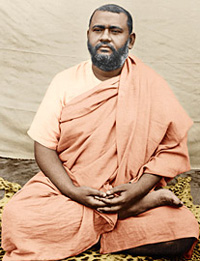
Swami Brahmananda reached Olavakkod (Shornnur) railway station on the 26th November 1916 byMadrasmail. From there he boarded a train to Ernakulam. Reached Ernakulam the same day and resided in a two storied building by the side of Periyar (Aluva) .Swamiji took a boat trip in the Periyar. Started to Kottayam on the 29th by boat. Spent two days in Kottayam. From Kottayam reached Haripad by car. Swamiji was received in front of Sree Subrahmanya Swamy temple with Poornakumbha, Pallak and Music. Went to the Ashram at Pilapuzha, one and a half kilometers away from the temple, leading a procession. Stayed in the Ashram for three days. He gave initiation to Neelakanta Bhaktan(Swami Purushothamananda) from Thiruvalla and Venkita Subrahmanya Iyer (Swami Chitsukhananda) of Haripad who donated the land for constructing the Ashram. From Haripad Raja Maharaj went to Kollam. Stayed there for two days. From Kollam he went to Thiruvananthapuram and laid the foundation stone of the Sri Ramakrishna Ashram, Nettayam at 8 am on the 9th December 1916. Swamiji reached Kollam on the 30th December. From Kollam went to Ambalapuzha, then to Ernakulam and to Madras. From Madras went to Kolkota.
Swami Nirmalananda again reached Haripad on the 22nd December 1923. The next day he conducted a Virago Home at the Ashram and gave Ochre clothes to eleven Brahmacharis namely Swami Chitsukhananda, Swami Nirvikarananda, Swami Niranjanananda, Swami Sekharananda, Swami Chidambarananda, Swami Naishtikananda, Swami Chitbhasananda, Swami Shubhrananda, Swami Vageeswarananda and Swami Dheeswarananda. After attaining sanyasa, Swami Chitsukhananda became head of the Haripad Ashram. The centre developed very fast. Sri Ramakrishna Vidyalaya was established mainly for the study and upliftment of the children belonging to the lower castes. A spinning loom centre was started for vocational training and employment. Charitable and social programmes in addition to spiritual activities were regularly conducted. The Ashram developed as a centre of spiritual excellence. Celebrations were conducted in a royal manner.
From 1942 Swami Sekharananda headed the centre. In 1964 a library was inaugurated by Sri V.V. Giri, the former President of India while he was The Governor of Kerala. In 1978 the Monk who headed the centre passed away.
THE FLOW OF EVENTS
By 1930 a difference of opinion arose between Swami Nirmalananda and some of the Board of Trustees of The Ramakrishna Mission, Belur on his accepting the chairmanship of Vivekananda Mission, Calcutta. This kept him away from the central leadership of the Mission. Swamiji came to Ottappalam and stayed there till his last breath on the 26th April 1938. By this time many centres started functioning in Kerala. Most of the centres including Haripad stood by him and dissociated with Belur Math. When the monk in charge of the Haripad centre passed away nobody in the Sri Ramakrishna order was substituted. A litigation between a section of local people and the Mission arose resulting the centre and its movable and immovable properties coming under the control of an Official Receiver appointed by the court. For some time Swami Golokananda who was heading the Thiruvananthapuram centre looked after the court proceedings. Thereafter, Swami Sakrananda who was President of the Trichur centre took the responsibility of conducting the process with the help of the noted business man turned spiritual activist Sri K Prabhakaran Nair. During this period Swami Kaivalyananda took charge of the Kayamkulam centre. Being young and dynamic he managed to handle the activities. The litigation went on from lower court to upper courts and vice versa.
In 1987 monthly retreat started in a rented building in the town under the leadership of Sri Prabhakaran Nair. One or two times this retreat was conducted in the Ashram itself with the permission of the court which later became difficult to obtain. Swami Sakrananda and Swami Niswananda used to attend the monthly retreat. After one year Swami Sakrananda expressed their their inability to attend every month. He promised to arrange a monk belonging to this order. Later Sakranandaji informed that a young and enthusiastic monk has taken over charge of the Palai centre and he has agreed to attend the retreat. Thus Swami Swaprabhanandaji came to the scene. The retreat went on smoothly with lalitha sahasranama archana, study of bhagavad gita, bhajans and arati in the morning session followed by lunch Prasad and reading from Sri Ramakrishna vachanamritha and Upanishad classes in the afternoon session. Prasad and food were prepared and brought from Sri Nairs house .Much man power was necessary for this. So the retreat was later shifted to Prabhakaran Nairs house at Pallipad. By this time many of the devotees from Haripad got initiated and used to attend the functions of the mission. After twelve years the retreat was arranged to be conducted in the devotees houses, with a view to spread the message in and around the surrounding villages. A large number of people including children used to attend the retreat regularly. The first All Kerala Sri Ramakrishna Bhakta Sammelan was held at Ernakulam on the 11th and 12th May 2002. Fifteen devotees from Haripad attended the function, the highest number from a non-affiliated centre. Activities that of a centre with regular programmes and retreat continued. The devotees kept in touch with other centres, attended the celebrations there, and took part in the sammelans. This process went on smoothly under the guidance of Swami Swaprabhananda and advice of Swami Kaivalyananda.
THE LILA OF SRI RAMAKRISHNA
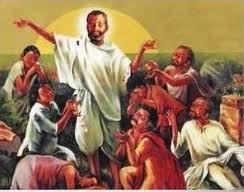
By GURU MAHARAJ’S grace, the Sub Court Mavelikara in its final judgment on the 6th October 2007 directed the Belur Matt Kolkota to appoint a sanyasin to head the Haripad centre and to advice a list of eight devotees from Karthikappally and Mavelikara Taluks to assist him in carrying on the activities of the centre. As such The Belur Matt appointed Swami Golokananda of Kozhikode centre to Haripad Swamiji took possession of the remaining unfertile sand and existing old trees at 2pm on the 15th December 2007.
The assets and resources flowed away during the custody of the centre with the Receiver. The building, furniture, vessels, library books, every thing even the photos of Guru Maharaj, Mathrudevi, Swamiji Maharaj kept in the shrine vanished.
THE WORK BEFORE US
From 2007 on-wards, after the centre was taken up by Ramakrishna Math, Belur Math regular activities are going under the care of a Monk from Belur Math. Please see our activities link.
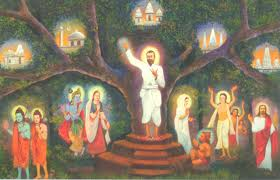
We have to rebuild the Haripad Centre from the beginning.
You are welcome to serve Sri Ramakrishna and his work. ( Please see Home Page link. )
JAI SRI RAMAKRISHNA
SARVA LOKAYA MANGALAM
(Courtsey– matter taken from the article by the devotee Attupuram Mohan)
News & Events
-
Appeal for Donation
You can donate to us using any of these methods: Google Pay/BHIM Pay, Bank Transfer, Cheque, DD, or... -
GOOD WISHES & PRAYERS FOR GOOD HEALTH DURING CORONA VIRUS SITUATION
DEAR DEVOTEES & WELL WISHERS IT IS MORE THAN A WEEK THAT CORONA VIRUS THREAT HAS LOOMED ALL OVER ... -
HARIPAD RKMATH Flood Relief Completed
Update on 6-9-2018 Dear Friends Flood relief Activities by Ramakrishna Math Haripad have been co... -
Notebook Drive by Ramakrishna Math Haripad
PHOTOS OF POOR STUDENTS GETTING FREE NOTE BUKS. WITH YOUR KIND HELP WE HAVE SPENT RS. 1,17,000 ( ... -
FOUNDATION STONE LAYING OF SADHU NIVAS AT HARIPAD ON 2ND MAY 2018
... -
Gurupoornima Celebration on 29th July 2018
... -
The Foundation Stone laying ceremony of the MONASTIC HOSTEL ( SADHU NIVAS)Will be held ON 2nd May 2018
Details can be seen here :- Foundation Stone Laying (more…)... -
Swami Vivekananda Jayanti Celebrations on 7 Jan 2018
... -
Message on 01.01.2018 (Sri Ramakrishna Kalpataru Day)
01.01.2018 (Sri Ramakrishna Kalpataru Day) Dear devotees, well wishers and friends N... -
YOUR KIND HELP NEEDED
YOU KNOW WE ARE STRIVING HARD TO BUILD THE HARIPAD RAMAKRISHNA MATH FROM THE BASE. YOU HAVE BEEN A...
Media Resources
Recent Articles
- श्री रामकृष्ण परमहंस की जीवनी की सचित्र हिंदी डॉक्यूमेंटरी
- Talk in Tamil: Asaiyum Arugadaiyum( Desiring n Deserving)
- Chanchalam Hi Manaha Krishna Part I (Hindi)
- How to overcome crisis: Japa Yajna Blessings Swami Virabhadrananda
- Lectures by Swami Virabhadrananda
View All

